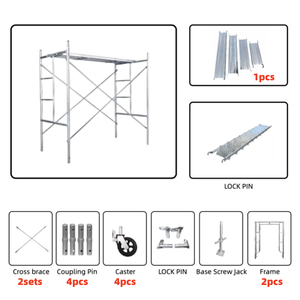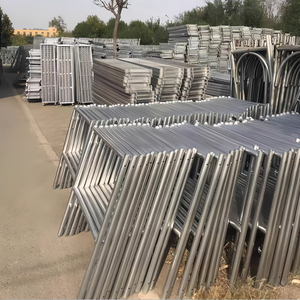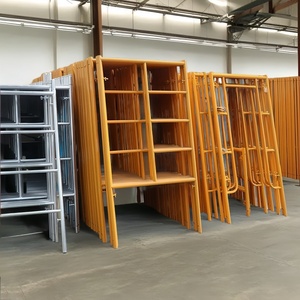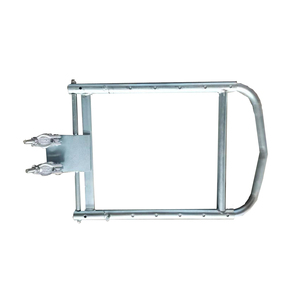
All categories
Featured selections
Trade Assurance
Buyer Central
Help Center
Get the app
Become a supplier

(31 products available)




















































A scaffold swing gate is a type of safety gate used on scaffolding platforms to provide secure access points. Here are the main types:
Single Swing Gate
This is the most common type of scaffold swing gate. It's a single door gate that swings open in one direction. The single swing gate is usually installed in less crowded areas. It requires less space to operate. It is also less expensive and less complicated to install and maintain.
Double Swing Gate
This type of gate is made up of two doors that swing open from the center. It is suitable for wide openings and provides easy access. The double swing gate is ideal for high-traffic areas. It enhances access and convenience. It also adds more strength and stability to the gate.
Self-Closing Gate
This type of swing gate automatically closes after being opened. It is equipped with hydraulic or pneumatic closing mechanisms. This makes it a good option for high-risk areas. It is also convenient for areas that require hands-free operation. Plus, it improves safety by ensuring the gate is always in a closed position.
Heavy-Duty Gate
This type of scaffold swing gate is constructed with robust materials. For example, high-strength steel or reinforced aluminum. It is designed to withstand harsh environments and heavy usage. The heavy-duty gate is usually ideal for scaffolding applications. It requires the support of larger loads and higher traffic frequency.
Telescopic Swing Gate
This type of gate is sliding and consists of overlapping sections. It is ideal for tight spaces where traditional swinging gates cannot fit. The telescopic swing gate is suitable for scaffolding openings. It is characterized by limited clearance or restricted space. It maximizes access and minimizes obstacles.
Wind-Resistant Gate
This type of scaffold swing gate is specifically designed for sites. Where wind conditions are harsh or prevalent? It is constructed aerodynamically. This minimizes wind resistance when the gate is closed. The wind-resistant gate is reinforced to withstand pressure from strong winds.
Scaffold swing gates are temporary safety devices installed on scaffolding platforms to protect workers from falls. They are designed to withstand the harsh environment of construction sites.
Durable materials
Scaffold swing gates are made from high-quality steel or aluminum, which are both strong and lightweight. Steel swing gates can be galvanized or powder-coated to prevent rusting. Aluminum gates are usually welded but may have removable hinges for easy transportation. The swing gate's infill is commonly made of chain link or welded mesh.
Hinges and locking mechanisms
Heavy-duty hinges allow smooth gate operation, while reliable locking mechanisms ensure the gate remains securely closed when needed. Locking mechanisms include swing, pin, and drop bolts. They can be operated manually or automatically. The swing gate can be opened 90 or 180 degrees, depending on the site requirements. The hinge side of the gate must have a toe board to prevent tools and materials from falling off the edge.
Adjustable width and height
Many scaffold swing gates have adjustable width and height to fit different sizes of scaffolding. It's important to install the right size gate because too small a gate will not provide adequate protection. On the other hand, a gate that is too big will not be stable or secure. It's also important to install the right type of gate. For example, double gates are ideal for openings that are too large for a single gate.
Slip-resistant and high visibility
Metal swing gates often have a slip-resistant surface to prevent workers from slipping, even when the gate is wet or muddy. They are also powder-coated in bright colors, such as yellow or orange, to improve visibility and compliance with safety regulations.
Quick installation and removal
These gates are designed for easy installation and removal, usually without special tools. They are often fitted with safety clamps instead of welding. Some swing gates are foldable or collapsible for easy transportation and storage.
Along construction sites, there are various usage scenarios for swing gates. Some of the common usage scenarios include:
When purchasing a swing gate for scaffolding, it is essential to consider several factors to ensure safety and regulatory compliance. Here are some key factors to take into account:
Regulations and Standards
Look for local safety regulations and construction industry standards. The Occupational Safety and Health Administration (OSHA) guidelines may provide vital information on requirements for swing gates on scaffolds.
Material and Durability
Consider the material of the swing gates. Common alternatives include aluminum, steel, and composite materials. Aluminum is lightweight and resistant to corrosion, making it suitable for projects in humid areas. Steel is more robust and secure, but it may rust without proper treatment. Composite materials are durable and low-maintenance and can be designed to mimic the appearance of wood. Choose a material that will withstand the environmental conditions on the construction site.
Weight Capacity
Look at the weight capacity of the scaffold gates. They should be able to support not just their weight but also the weight of personnel and tools that will pass through. This is more essential for busy construction sites with high traffic flow in and out of the platform.
Gate Size and Fit
Look at the size of the swing gate to ensure it fits the scaffold structure perfectly. Take accurate measurements of the opening where the gate will be installed. Consider the height and width of the swing gate to allow for easy access and efficient workflow on the construction site.
Security Features
Look for features that will boost the security of the swing gates. This includes; robust locking mechanisms, handrails, and higher weight-bearing capacities. Some locking alternatives include slide bolts, padlocks, and lever handles. Ensure the locking mechanism is easy to operate but secure enough to prevent accidental openings.
Customization
Some suppliers provide scaffold swing gate customization alternatives. This allows construction companies to request specific dimensions, materials, or design elements to fit their precise needs. Customization guarantees the gate integrates perfectly into the existing scaffold system and meets particular project requirements.
Q1: What is the weight capacity of a swing gate?
A1: There are no universal swing gate weight capacity standards. Each swing gate's weight capacity will vary based on the material, size, and structure. However, all types of swing gates can withstand enormous pressure. For instance, aluminum swing gates are lightweight but very strong. They boast incredible strength and rigidity, and their size and structure will determine their strength. As a rule, the bigger an aluminum swing gate, the more pressure it can withstand.
Q2: What is the maximum width for a swing gate?
A2: There is no definite maximum swing gate width. The width of a swing gate can increase or decrease depending on the material used to build it. However, as a general rule, the width of a swing gate, no matter the material used, should not exceed 16 feet. When a swing gate surpasses this width, it will become difficult to lift and hang. Also, the wind will easily catch the gate, causing damage over time.
Q3: Are swing gates safe?
A3: Yes, all types of swing gates are safe. They boast durable and robust construction, which makes them long-lasting and hard to break. Swing gates also have many finishings, like powder coating, which prevent rust and corrosion. Most swing gates also come with safety features like keypads, cameras, and access control systems.
Q4: What is the maximum height for a swing gate?
A4: There are no universal height standards for swing gates. A swing gate's height will vary depending on the material used to construct it. Also, environmental factors like wind patterns and where the gate is installed will impact its height. However, as a general rule, no swing gate should exceed 10 feet in height. Beyond this height, it becomes difficult to hang and operate.
Q5: How does wind affect a swing gate?